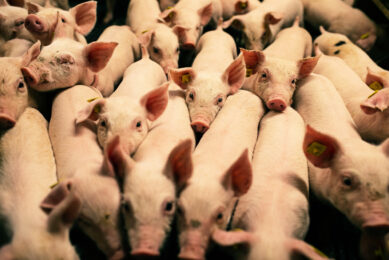What’s in the piglet feed?

When evaluating a new piglet feed for your farm, you need to have a ready list of tough questions to ask the seller to ensure you buy a quality product. After all, piglet feed is the most expensive feed you buy and you better not waste money! So, here are some easy and not so easy questions to add to your interview process.
A.©How cereals are treated?
Ideally, cereals should be thermally processed, at least for the first feed post-weaning, which our discussion here mainly focuses on. Thermal processing (cooking) makes cereal more digestible and palatable, and also reduces scours. Also, cereals should be finely ground to enhance digestibility and thus, growth. You can tell if cereals are overcooked or coarsely ground by the presence of dark specs (burnt) or large particles (coarse grind) in the feed, respectively. Break up some pellets and give them a close look.
B.©What is the lactose level?
Here, the higher the better, but too much may cause pigs to scour. Ask the technical services of your supplier to evaluate your production system and suggest the appropriate level of lactose to maximise feed intake without the risk of scours. Unfortunately, one lactose level does not suit all farms! I found this out the very hard way…
C.©How hard are the pellets?
Piglets don’t really care for small or large pellets, or for pellets with too many fines (again, we’re talking about the first feed post-weaning and not about later diets). What is of most relevance to weaned piglets is pellet hardness. Simply, they cannot chew hard pellets and as such they refuse to eat them. So, soft pellets are the ones to prefer. A soft pellet breaks easily when squeezed hard between two fingers. Better, ask your supplier for comparison data with their competitor’s feed. The testing device is really inexpensive!
D.©How much soybean protein is in the diet?
Usually, too much and that’s why many piglet diets cause diarrheas. Ideally, soybean meal should be avoided completely and only soy protein and extruded soybeans should be used, and again as part of the whole protein profile. This is often a ‘secret’, which in my book reads as way too high levels of soybeans in the feed!
E.©What animal proteins are used?
Here we’re looking for fish meal mainly, but other ingredients are also acceptable. For fish meal, we’re looking for a high concentration, up to 10%, and if possible, from the so-called low-temperature fish meal (meaning it was cooked slowly hence it maintains better its nutritive value). Be skeptical when alternatives are used because there are some ‘rotten fish’ among them…
F.©What immunoglobulins are in there?
The usual answer is animal plasma (for expensive feeds, that is) and the more the better, but this gets very expensive quickly. So, the more sophisticated and modern feeds contain antibodies from hyper-immunised eggs, which are more specific than those from plasma and they are also quite less expensive! Ask to know the supplier and the titers used.
G.©What additives are included?
The less the better because this indicates confidence in the raw materials and diet design. You want to see organic acids used for sure (where antibiotics are now banned), but beyond that not much, perhaps a prebiotic? I am skeptical when I smell aromas because they might hide something ‘fishy’. Still, a nice aroma makes the barn more pleasant, no?
H.©What feed intake should I expect the first week post-weaning?
This question you should actually answer it yourself, once the new feed arrives at the farm, but preliminary field data from the supplier should clearly point to about 200 grams per day during the first week post-weaning (assuming weaning takes place between three and four weeks of age). Anything grossly below 200 grams is simply unacceptable because pigs will suffer from scours and slow growth throughout their life. I have seen feed been sold as quality (with the associated high price tag) that could not make pigs eat more than 40 grams per day in the whole first week. So, watch out for non-performing feeds out there!
In my own experience only the most proficient sales personnel are able to answer these questions. If your rep cannot answer the above, then ask for his technical support people to pay you a visit or call you. If this is not possible, then look elsewhere. In my opinion, the first feed post-weaning is too expensive and too important to settle down for less than the best, and unfortunately this is not so common!











